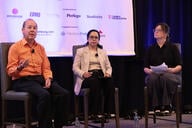You have /5 articles left.
Sign up for a free account or log in.
At the point of admission, we traditionally sort learners in a binary way, as either a freshman or a transfer student. While definitions may vary somewhat by institution, we can generalize that a freshman is a first-time college student, and a transfer student is a learner who has attended one or more institutions seeking enrollment at a new institution and is seeking the transfer of previously earned credits into that new institution toward a degree.
National reporting is centered on the data points pertaining to the first-time freshmen. We judge our institutions by the admission and successes of those who are sorted as freshmen. Institutional prestige and national rankings are often based on selectivity that is defined by the freshman acceptance rate; success is generally judged by the freshman graduation rate.
But with the increase of dual enrollment, Advanced Placement and International Baccalaureate programs, the defining characteristics between freshman and transfer students have blurred. As many as a third of those defined as a freshman carry some prior learning experiences to be evaluated and applied to their intended degree program. And according to NCES data, in the fall of 2020, there were more than 1.2 million degree-seeking transfer students enrolled in the U.S. Based on pre-pandemic data from the same source, that number will likely rise as we emerge from the current crisis.
By design, we are focused on moving the freshman student through our predetermined degree pathways. The institutional policies and processes in place to support that work assume a linear progression toward that goal: credits from prior institutions are examined and evaluated against a set of standards that check for accreditation, alignment with curriculum at the receiving institution and parity of credit hours with subjects taught.
Alternative credit paths are available if a learner has some other educational experience that is outside of the realm of traditional institutional credit. While the majority of institutions have such processes, including CLEP and ACE credit evaluation, credit for prior learning (CPL) processes are not widely promoted—mainly because the processes are generally cumbersome and time-consuming for both the learner and the institution. Learners must be persistent self-advocates to successfully navigate the system; CPL is an uncommon exception, designed to fit the learner and their experiences into the institution’s specific box that is the degree. The complex matrix of institutional policies regarding transfer and CPL create a systemic barrier for lower-income students, who, we know, based on data from the National Student Clearinghouse, are more likely to begin their education in a community college or other lower-cost setting.
The real problem? At the center of all of this is … the institution. Our focus is on our need to fit the learner into our processes, while we profess to be centered on the learner. I confident that as professionals in enrollment and academic services, we, at the American Association of Collegiate Registrars and Admissions Officers, as well as the sector as a whole, have our values in the right place, but it’s time we do the work to change processes, practices and policies to truly create a learner-centric ecosystem. AACRAO is in support of the many voices calling for this change, and we believe that our members have the capacity to re-envision transfer.
Of course, this is easier said than done. The learner that we are called to serve today is increasingly complex. Some chose to work before going to college; some are veterans; many are caretakers for parents or are parents themselves; most work at least part-time. Many have had a wide variety of formal and informal experiences from which they have achieved learning. And they are as ethnically diverse as the population as a whole. But it is clear these learners cannot be classified in the single monolithic profile of transfer.
Where we see the commonality is in their goals, and those goals are necessarily learner-centered. They are attending college to better their lives and advance their careers. They want institutions to value the variety of skills and achievements they have attained prior to enrollment; they do not want to repeat what they have already learned. They want their classroom work to feel relevant to their long-term goals. They are juggling their educational goals and the rest of their lives, so they need their path to degree to be as efficient—in both time and cost—as possible. And while they may not want (or be able to participate in) the traditional residential college experience, they want to feel like they belong.
We should be called to shift our focus from selectivity to inclusivity. If higher education is going to live up to our promise of being the engine driving equitable social and economic mobility, we have to stop sorting learners into one of two buckets and consider the whole of their experiences. And while we should be called to do this for reasons of equity and social justice, one might argue that it is also good business. In a time of shifting demographics and declining enrollments, it would also be wise for higher education as a whole to reconsider the focus as we shift our business models to prepare for and adapt to these changes. We can and must (re)think our intake pathways in a way that reflects not a binary freshman/transfer set of policies and practices but a holistic review of the learner’s prior experiences in a way that is systemic as opposed to exception-based. When we center our policies and practices on the learner, we can consider the larger landscape of learner mobility, from high school to college to workforce and beyond. When we center on the learner, we refocus on equitable lifelong learning for all.
Melanie Gottlieb is the executive director of AACRAO.


